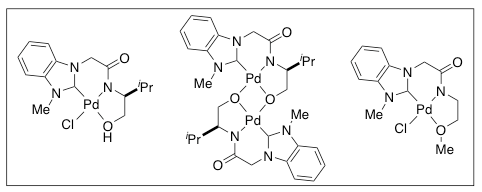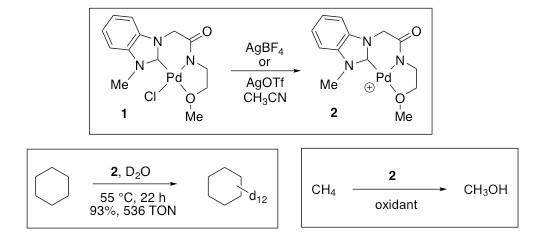
Associate Professor of Chemistry
Organic Chemistry
Ph.D., 1994, University of Wisconsin – Madison
M.S., 1987, Seoul National University
B.S., 1985, Seoul National University
Office: LHI 218
Phone: (213) 740-8768
Email: kwjung@usc.edu
Research Focus
Our research interests are organic synthesis, catalysis, and their applications to the fields of carbon-hydrogen bond activation, development of synthetic methodologies, and drug discovery.
Current projects are as follows:
1. Design & synthesis of novel catalysts.
2. Development of synthetic methodologies using our catalysts.
3. Synthesis of deuterium labelled pharmaceutical compounds.
4. Medicinal chemistry towards the first in class drug discovery.
1. Design & Synthesis of Novel Catalysts
We have designed and synthesized a number of organometallic catalysts for unprecedented and challenging reactions including carbon-hydrogen bond activation. Some of the most representative examples are novel NHC-amidate ligands and their metal complexes as shown below. In our general ligand design, we included an NHC ligand as a strong σ-donor and an amidate ligand as a strong σ-donor and possible p-electron donor. Thus, our designed NHC-amidate-Pd(II) complexes have a highly electron-rich Pd center. These properties of the NHC and amidate ligands would generate stable catalysts and improve catalytic efficiency. Such enhanced reactivity may facilitate challenging catalytic reactions, i.e., C-H bond activation of hydrocarbons such as methane.

2. Development of Synthetic Methodologies Using Our Catalysts
Our projected studies focus on the development of synthetic methodologies using our Pd catalysts, which can be either improvements over the existing methods or completely novel reactions. Some of the current projects are shown below.

Oxidative Palladium(II) Catalysis
Using oxidative Pd(II) catalysis, we have developed new synthetic methodologies, which include a modified Heck reaction. Under mild conditions, our boron-Heck reactions are highly efficient, giving rise to the stereoselective synthesis of various alkenes. As illustrated below, asymmetric catalysis has also been achieved to effect both intra- and intermolecular couplings. These methods are useful in the synthesis of medicinal compounds and natural products.

C-H Activation of Unreactive Hydrocarbons
Another approach using our newly designed NHC-amidate metal complexes is the development of novel catalytic reactions, which are challenging to carry out by utilizing known methods or catalysts. One area of our interest is the efficient C-H activation of hydrocarbons. For instance, cyclohexane was transformed to its deuterated form with 93% deuterium content and the catalytic turnover reached 536 at a mild temperature, 55 °C. Aromatic hydrocarbons such as benzene and toluene were also facile in the H/D exchange, providing up to 97% deuterium content.

Recently, we applied similar H/D exchange conditions to gaseous hydrocarbons, particularly methane because successful results can enlighten a new way of the C-H activation and ensuing oxidation of methane. With these methods developed, we embarked on the efficient conversion of methane to liquid products such as methanol using our catalysts.
3. Synthesis of Deuterium Labelled Pharmaceutical Compounds
Recently, deuterated versions of API’s (active pharmaceutical ingredients) have been increasingly attractive to pharmaceutical and biotech industries because deuterated medicines can exhibit improved safety profile owing to reduced metabolism compared to the existing parent drugs. Because C-D bonds are stronger than the corresponding C-H bonds, modification of existing drugs by deuterium incorporation can make the drugs more stable and more resistant to metabolic pathways. Reduced metabolism can increase the plasma concentration and half-lifetime of active drugs and reduce therapeutic doses with similar or improved efficacy. Inter-individual variability of liver enzymes can complicate the use of drugs due to variable degrees of metabolism and resultant drug-drug interactions. Deuterated drugs can alleviate this problem and help the use of medicines predictable and manageable compared to the parent drugs.

Using our novel Pd catalysts, our group has developed a practical and rapid procedure to generate deuterated drugs by catalytic H/D exchange in cheap D2O as the solvent and source of deuterium. We also developed an acid catalyzed H/D exchange methodology. Using these methods, our group has synthesized various deuterated versions of existing drugs including diclofenac. Currently, we are working on the synthesis and in vitro metabolism study of various deuterated API’s.
4. Medicinal Chemistry Towards the First-In-Class Drug Discovery
Our group has worked on a few drug discovery projects, which focus on unmet medical needs in various areas including RNA based rare diseases and CNS (central nervous system) diseases. As a representative example, our group is collaborating with Professors Lucio Comai and Sita Reddy’s groups at the USC Keck school of medicine.
Drug Discovery Towards RNA-based Rare Diseases
Our collaborative project targets rare diseases such as myotonic dystrophy type I (DM1), which is believed to stem from extensive repeats of certain bases in RNA as shown below. These repeats form loop structures, which ultimately cause abnormal RNA splicing. We have designed and synthesized compounds of various scaffolds to prevent the binding protein from ligating to the RNA loops, hoping that we can provide a potential treatment for DM1.

Presently, our group is working on the design and synthesis of inhibitors to prevent the aggregation of CUG repeated RNA loops and their binding proteins. Collaborators at the Keck have carried out the bioassays of our synthesized compounds while researching the mechanism of drug action and probing different types of assay methods. We hope that our collaboration will lead to the discovery of clinical candidates in the future.
Selected Publications
1. Oxidative Palladium(II) Catalysis: A Highly Efficient and Chemoselective Cross-Coupling Method for Carbon-Carbon Bond Formation under Base-Free and Nitrogenous-Ligand Conditions. Yoo, K. S.; Yoon, C. H.; Mishra, R. K.; Jung, Y. C.; Yi, S. W.; Jung, K. W. J. Am. Chem. Soc., 2006, 128, 16384.
2. Stereogenic Evolution of clasto-Lactacystin b-Lactone from (L)-Serine. Yoon, C. H.; Flanigan, D. L.; Yoo, K. S.; Jung, K. W. Eur. J. Org. Chem., 2007, 1, 37.
3. Asymmetric Intermolecular Heck-Type Reaction of Acyclic Alkenes via Oxidative Palladium(II) Catalysis. Yoo, K. S.; Park, C. P.; Yoon, C. H.; Sakaguchi, S.; O’Neill, J.; Jung, K. W. Org. Lett., 2007, 9, 3933.
4. Total Syntheses of (-)-a-Kainic Acid and (+)-a-Allokainic Acid via Stereoselective C-H Insertion and Efficient 3,4-Stereocontrol. Jung, Y. C.; Yoon, C. H.; Turos, E.; Yoo, K. S.; Jung, K. W. J. Org. Chem., 2007, 72, 10114.
5. Chiral PdII Complexes Possessing Tridentate NHC-Amidate-Alkoxy Ligand: Access to Oxygen-Bridging Dimer Structure. Sakaguchi, S.; Yoo, K. S.; O’Neill, J.; Lee, J. H.; Stewart, T.; Jung, K. W. Angew. Chem. Int. Ed., 2008, 47, 9326.
6. Chemoselective Three-Component Coupling via A Tandem Pd Catalyzed Boron-Heck and Suzuki Reaction. O’Neill, J.; Yoo, K. S.; Jung, K. W. Tetrahedron Lett., 2008, 49, 7307.
7. Highly Regioselective Heck-Coupling Reactions of Aryl Halides and Dihydropyran (DHP) in the Presence of NHC-Pyridine Ligand. Jarusiewicz, J.; Yoo, K. S.; Jung, K. W. Synlett, 2009, 482.
8. Air/Water-Stable Tridentate NHC-PdII Complex; Catalytic C-H Activation of Hydrocarbons via H/D Exchange Process in D2O. Lee, J. H.; Yoo, K. S.; Park, C. P.; Olsen, J. M.; Sakaguchi, S.; Prakash, G. K. S.; Mathew, T.; Jung, K. W. Adv. Synth. Cat., 2009, 351, 563.
9. Efficient Three-Component Strecker Reaction of Aldehydes/Ketones via NHC-Amidate Palladium(II) Complex Catalysis. Jarusiewicz, J.; Choe, Y.; Yoo, K. S.; Park, C. P.; Jung, K. W. J. Org. Chem., 2009, 74, 2873.
10. Expeditious Enyne Construction from Alkynes via Oxidative Pd(II) Catalyzed Heck-Type Coupling. Hadi, V.; Yoo, K. S.; Jeong, M.; Jung, K. W. Tetrahedron Lett., 2009, 50, 2370.
11. Formal Aromatic C-H Insertion for Stereoselective Isoquinolinone Synthesis and Studies on Mechanistic Insights into the C-C Bond Formation. Park, C. P.; Nagle, A. S.; Yoon, C. H.; Chen, C.; Jung, K. W. J. Org. Chem., 2009, 74 6231.
12. Tridentate, anionic tethered N-heterocyclic carbene of Pd(II) complexes. Sakaguchi, S.; Kawakami, M.; O’Neill, J.; Yoo, K. S.; Jung, K. W. J. Organometal. Chem., 2010, 695, 195.
13. Asymmetric Intermolecular Boron-Heck Type Reactions via Oxidative Palladium(II) Catalysis with Chiral Tridentate NHC-Amidate-Alkoxide Ligands. Yoo, K. S.; O’Neill, J.; Sakaguchi, S.; Giles, R.; Lee, J. H.; Jung, K. W. J. Org. Chem., 2010, 75, 95.
14. Efficient Diacetoxylation of Alkenes via Pd(II)/Pd(IV) Process with Peracetic Acid and Acetic Anhydride. Park, C. P.; Lee, J. H.; Yoo, K. S.; Jung, K. W. Org. Lett., 2010, 12, 2450.
15. Chemoselective hydroamination of vinyl arenes catalyzed by an NHC-amidate-alkoxide Pd(II) complex and p-TsOH. Giles, R.; O’Neill, J.; Lee, J. H.; Chiu, M. L.; Jung, K. W. Tetrahedron Lett., 2013, 54, 4083.
16. Dual studies on a hydrogen-deuterium exchange of resorcinol and the subsequent kinetic isotope effect. Giles, R.; Kim, I.; Chao, W. E.; Moore, J.; Jung, K. W. J. Chem. Educ., 2014, 91, 1220.
17. Hydrogen–deuterium exchange of aromatic amines and amides using deuterated trifluoroacetic acid. Giles, R.; Lee, A.; Jung, E.; Kang, A.; Jung, K. W. Tetrahedron Lett., 2015, 56, 747.
18. H-D exchange in deuterated trifluoroacetic acid via ligand-directed NHC-palladium catalysis: a powerful method for deuteration of aromatic ketones, amides, and amino acids. Giles, R.; Ahn, G.; Jung, K. W. Tetrahedron Lett., 2015, 56, 6231.
19. Hydroalkenylation: Palladium catalyzed co-dimerization of unactivated alkenes. Zargari, N.; de Prevoisin, G.; Kim, Y.; Kaneshiro, K.; Runberg, R.; Park, J.; LaCroix, K.; Narain, R.; Lee, B. D.; Lee, J. H.; Jung, K. W. Tetrahedron Lett., 2016, 57, 815.
20. Unexpected, Latent Radical Reaction of Methane Propagated by Trifluoromethyl Radicals. Zargari, N.; Winter, P.; Liang, Y.; Lee, J. H.; Cooksy, A.; Houk, K.; Jung, K. W. J. Org. Chem., 2016, 81, 9820.
21. Carbon dioxide hydrogenation: Efficient catalysis by an NHC-Amidate Pd(II) complex. Zargari, N.; Jung, E.; Lee, J. H.; Jung, K. W. Tetrahedron Lett., 2017, 58, 3330.
22. Nitrohydroxylation of Olefins with Nitric Acid Using Tridentate NHC–amidate–alkoxide Containing Palladium Catalysts. O’Neill, J.; Lee, J. H.; Kim, S.; Zargari, N.; Ketabchi, B.; Akahoshi, J.; Yang, F.; Jung, K. W. Topics in Catal., 2018, 61, 630.